
Coding assistants are becoming popular after the release of Claude Code and OpenAI Codex CLI. What followed was a flood of new tools, from Gemini CLI to Grok 4 Codex. Now, Qwen 3 enters the fray, aiming to rise as a powerful open-source alternative. Whether you’re facing a tough coding problem or simply looking for a smarter way to code, Qwen 3 offers a free, innovative solution. Designed for advanced code generation and flexible coding workflows, it’s perfect for both data scientists and AI enthusiasts. In this blog, we’ll explore what sets Qwen 3 apart.
What is Qwen3-Coder?
Qwen3-Coder is the newest and most powerful open-source AI model from the Qwen team. The flagship model in this series is the Qwen3-Coder-480B-A35B-Instruct, which boasts a massive 480-billion parameter architecture.
One key feature of this model is its use of a Mixture-of-Experts (MoE) architecture. This design allows the model to be more efficient by activating only a small portion of its parameters at any given time.
Key Highlights of Qwen3-Coder
- 480 Billion Parameters: The model is powered by 480 billion parameters, but only 35 billion are active during a query.
- Efficiency Through MoE: With the Mixture-of-Experts approach, only a select number of experts (who are well-versed in the relevant topic) are activated for a given task, making it powerful yet manageable.
- Long Context Window: It supports a context of 256,000 tokens, which can be extended up to 1 million tokensusing extrapolation.
- Extrapolation: This feature enables the model to process larger inputs than it was originally trained on, allowing for greater flexibility and capacity.
This immense context window allows Qwen3-Coder to understand and work with entire code repositories, making it an invaluable tool for developers.
Architecture of Qwen3-Coder
Qwen3-Coder is developed with the core idea to excel at agentic coding. Its architecture and training are designed to make it a top-tier model for code generation and code-related tasks.
- Mixture-of-Experts (MoE): The model uses an MoE architecture with 160 experts, of which 8 are active at a time. This permits the model to be very large and powerful without being slow.
- Massive Context Window: With native support for 256,000 tokens, Qwen3-Coder can handle large amounts of code directly. This is often crucial for understanding the context of a whole project.
- Advanced Training: The model was pre-trained on 7.5 trillion tokens of data, with 70% of that being code. It also went through a post-training phase that included reinforcement learning from human feedback to improve its ability to handle real-world coding tasks.
This advanced training was done to embrace a broader view, rather than focusing on competitive-level code generation in the community. The graph above shows the steady performance gains across a wide range of benchmarks, including code generation, software development, data analysis, competitive programming, multi-language coding, SQL programming, code editing, and instruction following. These consistent upward trends demonstrate the effectiveness of reinforcement learning in enhancing the model’s generalization across both structured and unstructured coding challenges.
Performance of Qwen3-Coder
Qwen3-Coder achieved a state-of-the-art agentic performance in comparison to other open-source models on the SWE-Bench benchmark. As shown in the graph, it achieves 69.6% verified accuracy in a 500-turn interactive setting and 67.0% in single-shot mode. It outperformed other models like Mistral-small-2507 with 53.6% and GPT-4.1 with 54.6% accuracy. It ranks just behind Claude-Sonnet-4 (70.4%) and ahead of Kimi-K2 (65.4%), and Gemini-2.5 (49.0%). This establishes Qwen3-Coder as the top-performing open agentic model for real-world software engineering tasks.
Getting Started with Qwen Code
To access Qwen Code directly, head over to https://chat.qwen.ai/, and there you can select Qwen3-Coder as the model and start using it.
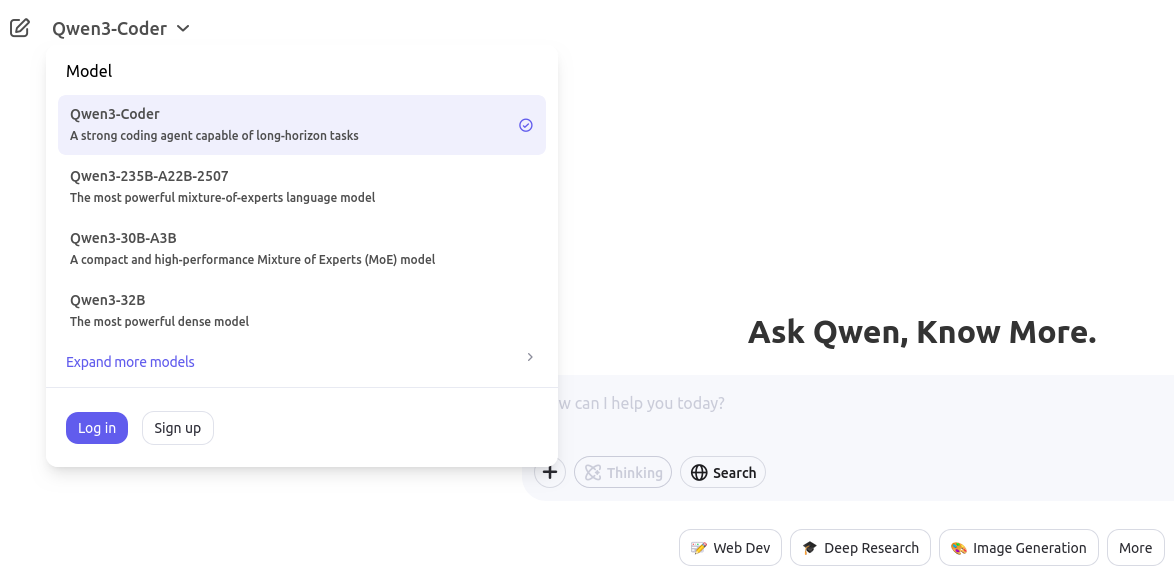
Qwen API
You can directly access the API of Qwen3-Coder through Alibaba Cloud Model Studio. Here is a demonstration of how to use this model with the Qwen API. As of now, no free quota is available.
import os
from openai import OpenAI
# Create client - using intl URL for users outside of China
# If you are in mainland China, use the following URL:
# "https://dashscope.aliyuncs.com/compatible-mode/v1"
client = OpenAI(
api_key=os.getenv("DASHSCOPE_API_KEY"),
base_url="https://dashscope-intl.aliyuncs.com/compatible-mode/v1",
)
prompt = "Help me create a web page for an online bookstore."
# Send request to qwen3-coder-plus model
completion = client.chat.completions.create(
model="qwen3-coder-plus",
messages=[
{"role": "system", "content": "You are a helpful assistant."},
{"role": "user", "content": prompt}
],
)
# Print the response
print(completion.choices[0].message.content.strip())The Qwen team has also released a command-line tool called Qwen Code to make it easy to use Qwen3-Coder. Here is a step-by-step guide to get you started:
How to Use Qwen Code?
Step 1: Install Node.js
First, you will need to install Node.js version 20 or higher on your system. You can install it with the following commands. Open your terminal and paste the following commands one by one.
# Download and install nvm:
curl -o- https://raw.githubusercontent.com/nvm-sh/nvm/v0.40.3/install.sh | bash
# in lieu of restarting the shell
\. "$HOME/.nvm/nvm.sh"
# Download and install Node.js:
nvm install 22
# Verify the Node.js version:
node -v # Should print "v22.17.1".
nvm current # Should print "v22.17.1".
# Verify npm version:
npm -v # Should print "10.9.2".Step 2: Install Qwen Code
Next, install the Qwen Code tool using the npm package manager:
npm i -g @qwen-code/qwen-codeYou should see something like this:

Step 3: Configure Your API Key
You can directly access the API of Qwen3-Coder through Alibaba Cloud Model Studio. As of now, no free quota is available.
You will need to set up your API key to use the model. You can do this by setting environment variables.
export OPENAI_API_KEY="your_qwen_api_key_here"
export OPENAI_BASE_URL="https://dashscope-intl.aliyuncs.com/compatible-mode/v1"
export OPENAI_MODEL="qwen3-coder-plus"Step 4: Start Coding
Now you are ready to use `Qwen Code`. You can navigate to your project directory and start interacting with the agent. For example, to understand the architecture of a project, you can use the command or just write the following command qwen code will pop up:
qwen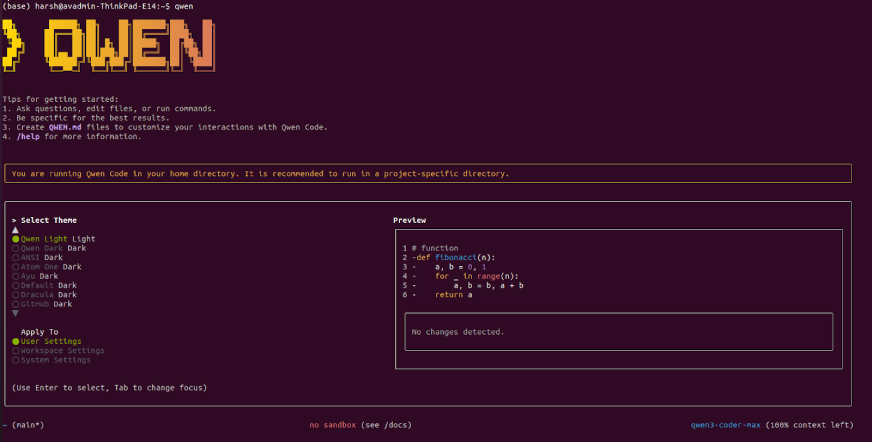
You can also use it for more complex tasks like refactoring code or even automating workflows.
How to Use Qwen3-Coder in Claude Code?
In addition to Qwen Code, you can now use Qwen3‑Coder with Claude Code. Simply request an API key on Alibaba Cloud Model Studio platform and install Claude Code to start coding.
npm install -g @anthropic-ai/claude-code
Set up environment variables for using Qwen3‑Coder
export ANTHROPIC_BASE_URL=https://dashscope-intl.aliyuncs.com/api/v2/apps/claude-code-proxy
export ANTHROPIC_AUTH_TOKEN=your-dashscope-apikeyThen you should be able to use Claude Code with Qwen3-Coder!
Note: You can use either Qwen CLI or Web Interface to perform coding tasks. Now, let’s perform some tasks to test Qwen3-Coder capabilities.
Hands-on Qwen3-Coder
We tested Qwen3‑Coder on some interesting and complex coding tasks. Let’s see how it performed. Here we are using the UI version, which is accessible at https://chat.qwen.ai/
Task 1: Smart Data Storyteller
Prompt: Build a data storytelling app where users can upload CSV files and ask natural language questions about their data. The AI should generate visualizations, identify patterns, and create narrative explanations of the insights. Include features for users to ask follow-up questions like ‘Why did sales drop in Q3?’ or ‘Show me the correlation between marketing spend and revenue.’ Make it accessible to non-technical users.
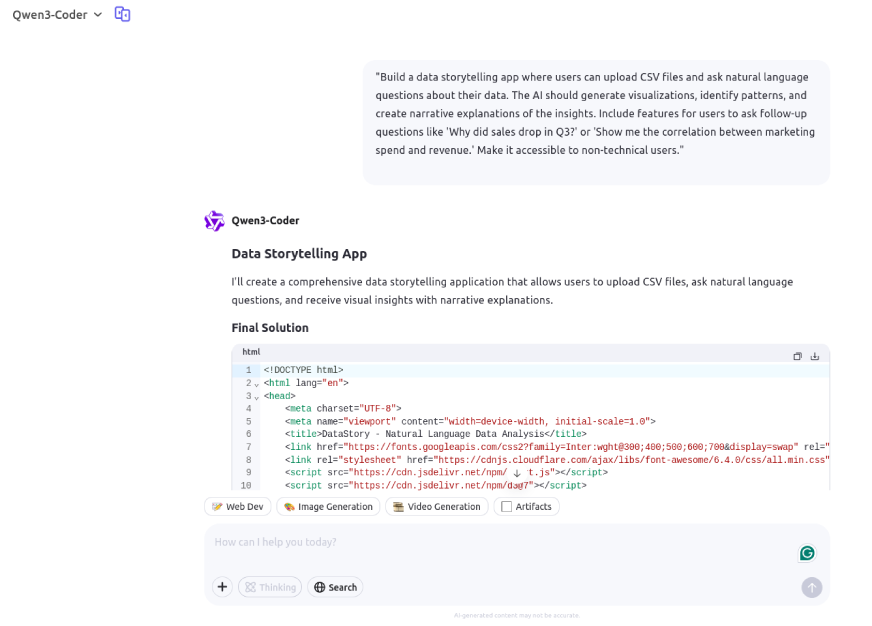
It took some time to generate the code, but it generated the full app in one script. When we tested on the HTML viewer, we got these results:
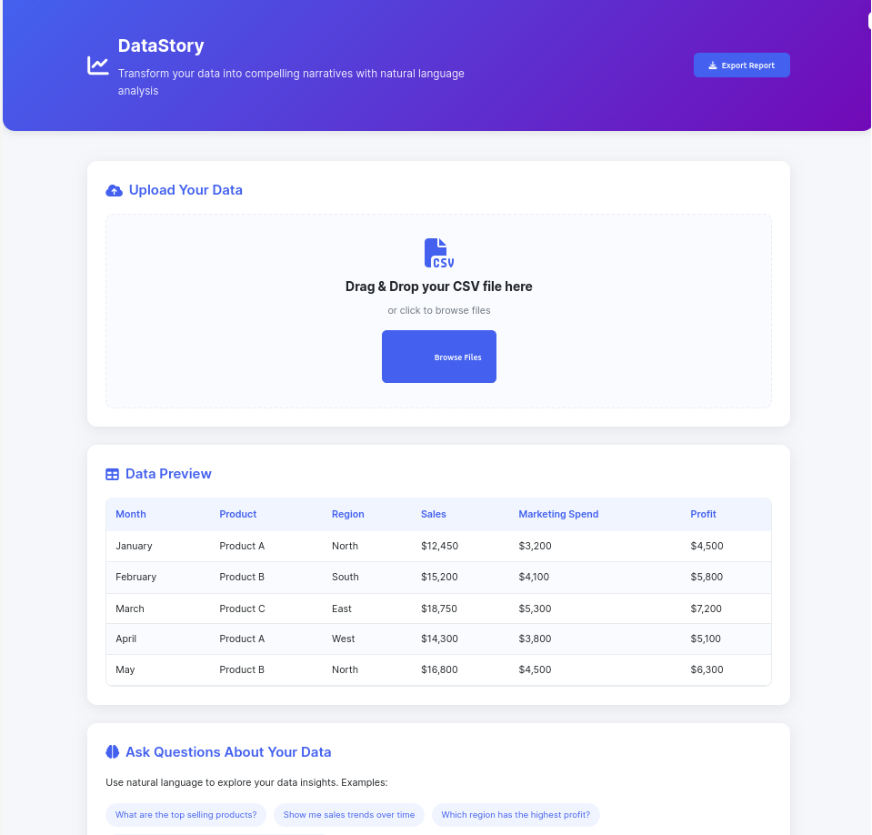
The app’s interface is interesting; it successfully handles file processing, which allows the app to handle file uploads. The rich UI components are created using React. The app is having responsive design, hence it proves that Qwen3-Coder is performing well in this task.
Task 2: Debugging and Refactoring a Complex, Bug-Ridden Codebase
Prompt: Act as a senior Python developer and code reviewer. I have a Python script that is supposed to process a list of user data from a mock API, filter for active users, and calculate their average age. However, it’s buggy, slow, and poorly written. Your task is to:
- Identify the Bugs: Find and list all the logical errors, potential runtime errors, and bad practices in the code.
- Fix the Code: Provide a corrected version of the script that works as intended.
- Refactor for Improvement: Refactor the corrected code to improve its performance, readability, and maintainability. Specifically, you should:
- Add error handling for the API request.
- Use a more efficient data structure or method if possible.
- Improve variable names to be more descriptive.
- Add type hints and comments where necessary.
- Structure the code into functions for better organization.
Here is the buggy code:
import requests
def process_users():
data = []
# Inefficiently fetching one user at a time
for i in range(1, 101):
# API endpoint is incorrect and will fail for some users
response = requests.get(f"https://my-mock-api.com/users/{i}")
data.append(response.json())
total_age = 0
active_users_count = 0
for user in data:
# Bug: 'status' key might not exist
if user['status'] == 'active':
# Bug: 'profile' or 'age' might not exist, will raise KeyError
total_age += user['profile']['age']
active_users_count += 1
# Bug: Division by zero if no active users are found
average_age = total_age / active_users_count
print("Average age of active users:", average_age)
process_users()Output:
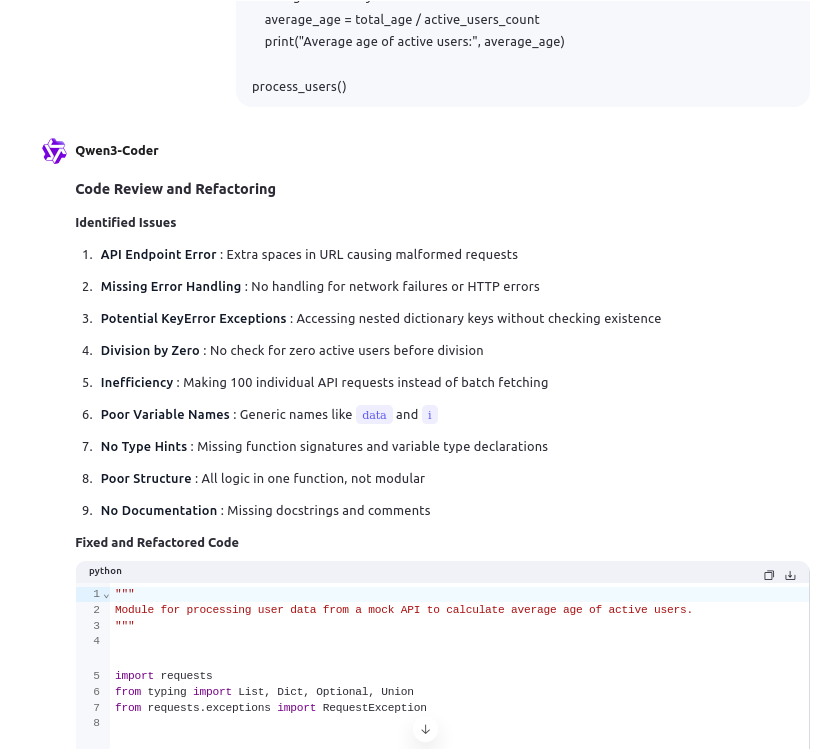
Qwen generated the solution in some time. Let’s look at its result:
- Good Things: Qwen added error handling and safe data access for API inputs. Code has good documentation, which makes it readable. The code is following standard code style.
- Areas to Improve: The code is longer and more verbose than the original due to the added error handling and modularity.: The fundamental inefficiency of making individual API calls in a loop has not been addressed. The introduction of more functions and error handling makes the overall structure slightly more complex for a beginner to grasp.
Overall, the code is good and took care of all the instructions given to it.
Task 3: Sun Terrain Visualization
Prompt: Create a 3D Sun terrain visualization using a single HTML file that incorporates CSS for layout and theming, and uses only external CDN libraries—primarily Three.js and OrbitControls—to render a realistic, rotating Sun. The Sun should feature dynamic surface activity using animated bump or displacement maps to simulate solar granulation and flares, giving it a terrain-like texture. Include a dark space-themed background with stars for environmental realism. Ensure the visualization is interactive, supporting mouse drag rotation and scroll-based zooming. All textures and shaders must be sourced from public CDNs or procedural generation methods, with no local or uploaded assets.
Output:
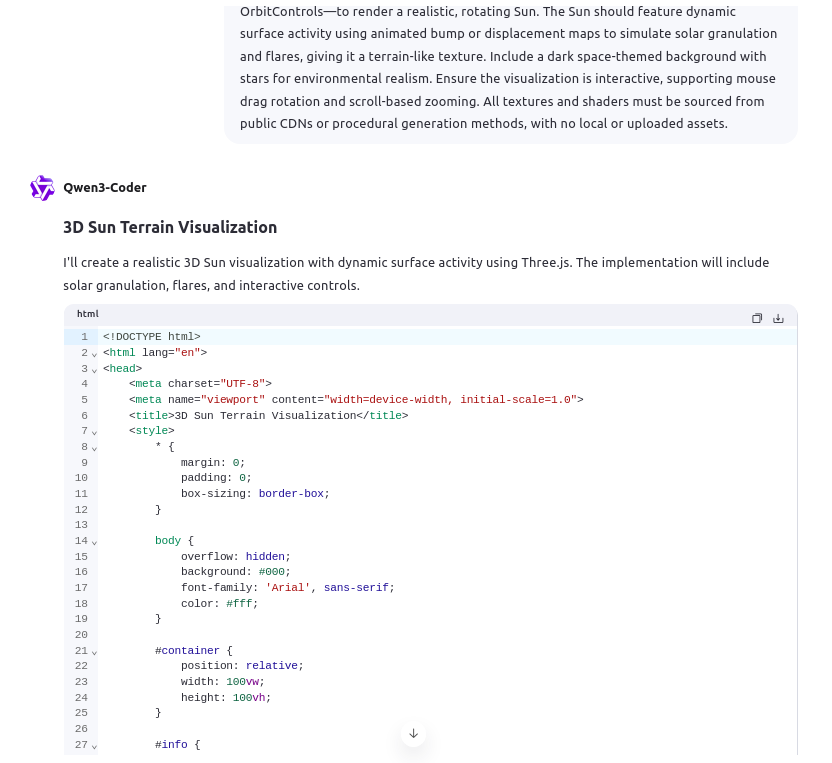
It quickly generated an html code when we tested
Conclusion
Qwen3-Coder represents an enormous breakthrough in open-source AI models within the domain of code generation. Its powerful architecture, massive context window, and agentic capabilities make it a valuable tool for developers and researchers. Because the model continues to be developed, we will expect to see even more impressive features and performance in the future. This open-source AI model is set to have a significant impact on how we approach software development problems, making it more efficient and automated.
Frequently Asked Questions
A. The MoE architecture allows the model to have a very large number of parameters (480 billion) while only activating a fraction of them (35 billion) at a time. This results in a powerful model that is more efficient to run.
A. The 256,000-token context window (extendable to 1 million) allows Qwen3-Coder to process and understand entire code repositories, which is crucial for complex tasks that require a deep understanding of the project’s context.
A. Qwen Code is a command-line tool designed to work with Qwen3-Coder. It provides a convenient interface for interacting with the model for various coding tasks.
A. Qwen3-Coder has demonstrated state-of-the-art performance among open-source models on several benchmarks, including SWE-bench. Its capabilities are comparable to some of the best proprietary models available.
A. The Qwen3-Coder model is available on the Hugging Face Hub, and you can find more information and resources on the official Qwen blog and GitHub repository.
Login to continue reading and enjoy expert-curated content.







